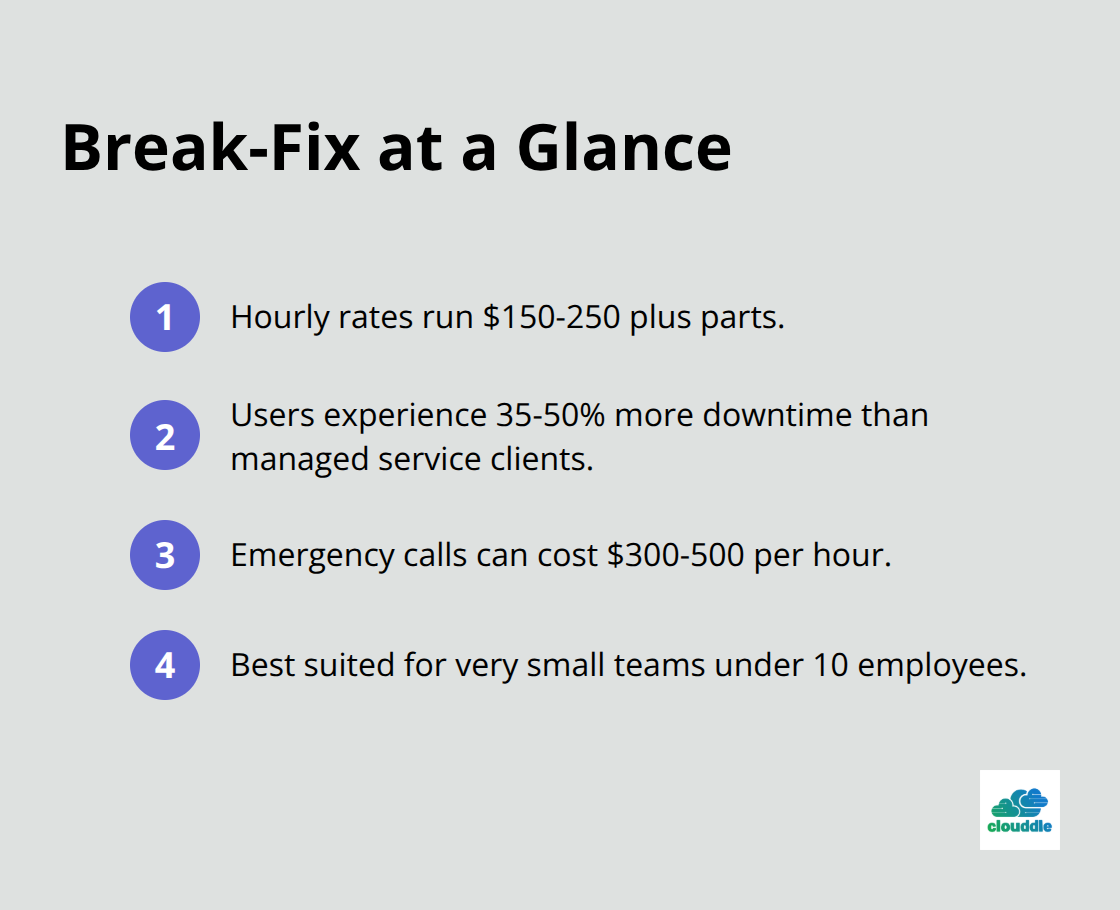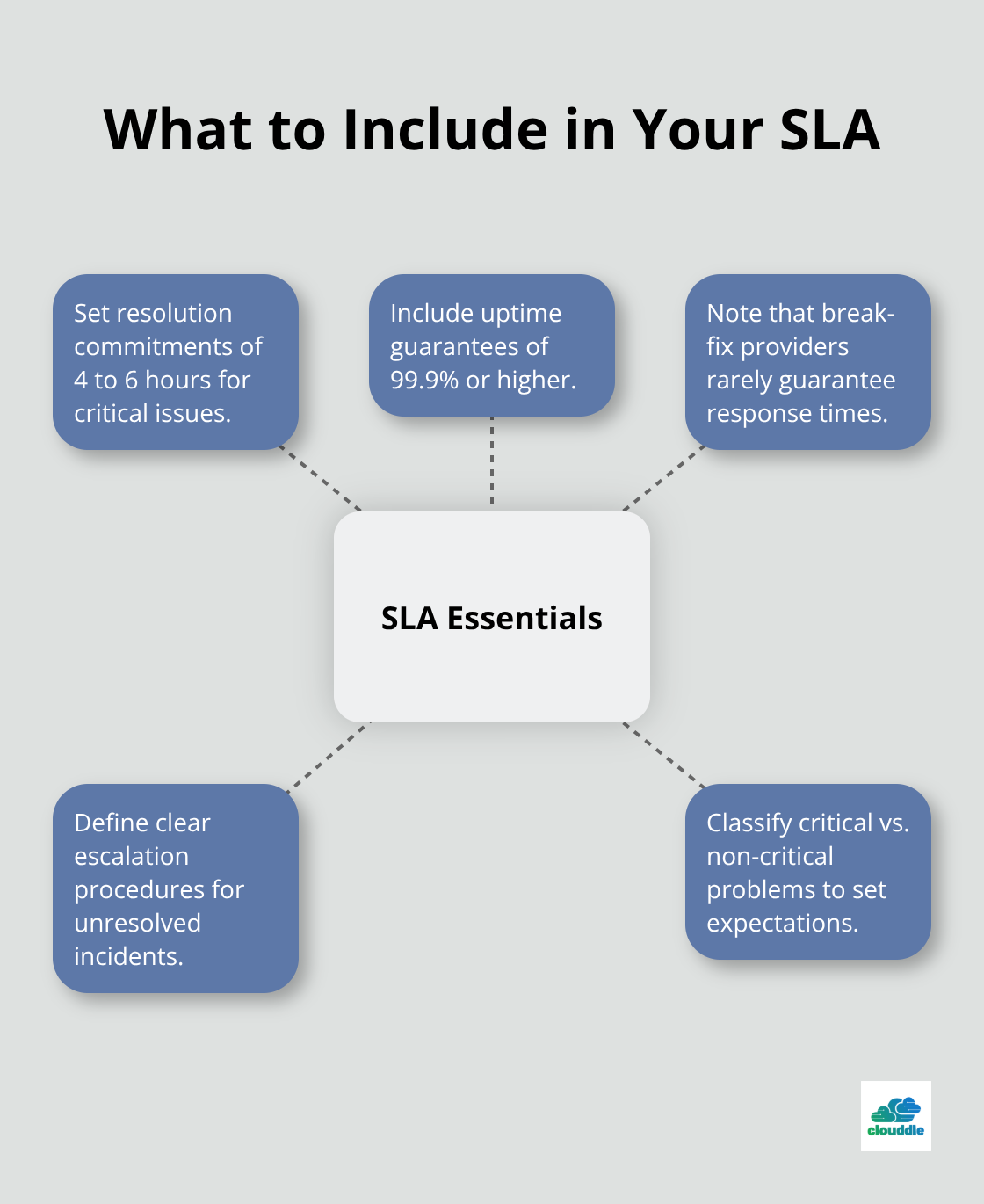Small businesses lose an average of $427 per minute during IT downtime, according to Gartner research. The right IT support packages can prevent these costly interruptions while keeping your systems running smoothly.
We at Clouddle understand that choosing between managed services, break-fix support, or hybrid models feels overwhelming. This guide breaks down each option to help you find the perfect fit for your business needs and budget.
Which IT Support Model Fits Your Business
Managed IT Services Transform Operations
Managed IT services operate on a flat monthly fee structure that covers comprehensive monitoring, maintenance, and support. Companies using managed services report significant reductions in unexpected IT costs, with 70% of businesses experiencing these benefits according to CompTIA research. This approach includes 24/7 network monitoring, automatic patch management, cybersecurity protection, and regular system updates. Most managed service providers guarantee response times under 15 minutes for critical issues and offer unlimited support calls.
The predictable monthly cost typically ranges from 0-300 per user (making budget planning straightforward).
Break-Fix Creates Costly Surprises
Break-fix support charges only when problems occur, with hourly rates between $150-250 plus parts costs. While this seems economical for businesses with minimal IT issues, studies show break-fix users experience 35-50% more downtime than managed service clients. Emergency calls often carry premium rates of $300-500 per hour, and parts procurement delays can extend outages for days. Break-fix works best for very small businesses with fewer than 10 employees and simple technology setups, but growth quickly makes this model expensive and unreliable.

Hybrid Models Balance Control and Support
Hybrid support combines internal IT staff with external expertise for specialized areas like cybersecurity or cloud management. This model costs 20-30% less than full managed services while providing expert knowledge for complex projects. Companies retain control over daily operations but access professional support for strategic initiatives, compliance requirements, or advanced security threats. Hybrid arrangements work particularly well for businesses with 25-100 employees who need specialized skills without full outsourcing.
Key Factors Shape Your Decision
Your business size, technical complexity, and growth plans determine which model serves you best. Small startups might start with break-fix support, while established companies benefit from managed services’ predictability (especially those handling sensitive data or compliance requirements). The next step involves evaluating your specific business requirements and budget constraints to make an informed choice.
How Do You Choose Your Perfect IT Support Package
Your business requirements determine which IT support package delivers the best value. Companies with 1-10 employees typically need basic support for email, file sharing, and simple network issues (making break-fix services adequate initially). Mid-sized businesses with 25-100 employees require comprehensive monitoring, security management, and strategic planning that only managed services provide effectively. Enterprise organizations above 100 employees benefit most from hybrid models that combine internal expertise with specialized external support for compliance, advanced security, and cloud infrastructure.
Budget Analysis Reveals True Costs
Break-fix hourly rates of $150-250 seem affordable until emergency situations arise. Microsoft research shows businesses using reactive support experience enhanced operational efficiency and reduced downtime when switching to proactive managed services. Managed services cost 0-300 per user monthly but include unlimited support, proactive monitoring, and predictable expenses that simplify financial planning. Calculate your total technology spending over 12 months including emergency repairs, lost productivity, and security incidents to compare real costs accurately.
Service Level Agreements Define Performance Standards
Response time commitments separate professional providers from amateur operations. Leading providers typically offer 4 to 6 hour resolution standards for critical issues, with 99.9% uptime guarantees common among top-tier services. Break-fix services rarely offer guaranteed response times, often taking 24-48 hours during busy periods. Service level agreements should specify uptime guarantees of 99.9% or higher, escalation procedures for unresolved issues, and clear definitions of critical versus non-critical problems. Providers that offer vague commitments or response times exceeding industry standards lack the infrastructure to support growing businesses effectively.

Technical Expertise Matches Business Complexity
Small businesses with basic technology needs can often manage with general IT support, while specialized industries require providers with specific knowledge. Healthcare organizations need HIPAA compliance expertise, financial services require SOX compliance understanding, and manufacturing companies benefit from industrial network experience. Evaluate potential providers based on their certifications, industry experience, and technical specializations that align with your business requirements. The right IT support package becomes the foundation for implementing advanced security measures and data protection strategies.
Why Professional IT Support Transforms Business Performance
Professional IT support delivers measurable business improvements that directly impact your bottom line. Companies with managed IT services benefit from outsourced IT tasks including help desk, network monitoring, software updates, and business continuity provided by third-party vendors. This comprehensive support translates to significant productivity gains for employees. Organizations with professional IT support resolve critical issues faster than internal teams, which reduces average incident response times. The productivity gains compound quickly – businesses report faster project completion rates and reduced employee frustration related to technology problems.
Security Breaches Cost More Than Prevention
Cybersecurity incidents cost small businesses significant amounts per breach, with many affected companies closing within months according to industry research. Professional IT providers implement multi-layered security that includes endpoint detection, email filters, and network monitors that catch threats before they cause damage. Managed security services provide cost-effective monthly protection per employee while preventing breaches that could destroy businesses completely. Companies with professional cybersecurity support experience fewer successful attacks and recover from incidents faster than those that rely on basic antivirus software alone.
Expert Knowledge Accelerates Technology Adoption
Professional IT teams bring specialized expertise that internal staff cannot match across multiple technology domains. Microsoft 365 implementations take professional providers weeks compared to months for internal teams that attempt the same migration. Cloud infrastructure projects succeed more frequently with expert guidance versus self-managed initiatives according to industry analysis. Professional providers maintain current certifications across dozens of platforms, which means your business adopts proven solutions rather than experiments with untested approaches that waste time and money.
Final Thoughts
The right IT support packages transform your business operations through predictable costs and proactive protection. Companies with fewer than 10 employees often start with break-fix services, while organizations above 25 employees benefit from managed services that provide comprehensive monitoring. Your decision should factor in total cost of ownership, including downtime expenses that average $427 per minute (according to Gartner research).
Professional IT support delivers measurable returns through reduced downtime, enhanced security, and access to specialized expertise that internal teams cannot match. The long-term value extends beyond cost savings to include improved productivity, faster technology adoption, and protection against cyber threats. These benefits compound over time as your business scales and technology requirements become more complex.
The right IT partner evaluates service level agreements, response time commitments, and industry-specific expertise before making recommendations. Clouddle provides comprehensive technology solutions with 24/7 support and flexible contracts. Professional IT support transforms from an operational expense into a strategic advantage that enables business growth and operational efficiency.


